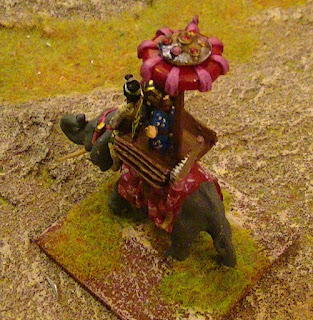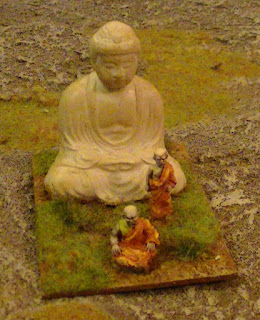Constituted in the simple DBA format (12 elements), it is also intended to serve as an allied body of my Siamese army, in BBDBA. Like the Siamese, the Khmers will mostly be individually transformed. Completing this army will take quite a long time.
Played alone, the army represents that of the empire at its peak during the reign of Jayavarman VII (XIIth century). Played as an ally of the Siamese, it represents a much darker period in the history of this people, in the XIVth century. The differences in clothing are sufficiently small to permit this great chronological deviation.
The elephants. The army being built in DBA format (in big battle, my Khmers constitute an allied body for my Siamese), it has only two elephants. That of the prince (with the parasol) and that of the regular troops. The army being supposed to represent troops influenced by suzeraun Siamese, I endowed these aristocrats with the Siamese helmet typical.
Played alone, the army represents that of the empire at its peak during the reign of Jayavarman VII (XIIth century). Played as an ally of the Siamese, it represents a much darker period in the history of this people, in the XIVth century. The differences in clothing are sufficiently small to permit this great chronological deviation.
The elephants. The army being built in DBA format (in big battle, my Khmers constitute an allied body for my Siamese), it has only two elephants. That of the prince (with the parasol) and that of the regular troops. The army being supposed to represent troops influenced by suzeraun Siamese, I endowed these aristocrats with the Siamese helmet typical.
The "long shield" infantry offers good troops for bad going (4Ax)
The Khmer artillery could be mounted on an elephant or equipped with wheels. This is the version I have chosen. It is a piece of artillery made by conversion.
The initial idea of the realization comes from the illustration below (depicting a victorious Thai army escorting Khmer prisoners.) The destroyed ballista, in the front row, is a Khmer ballisticist.
Like the other figures in the army, the ballista is a converted piece. I started from a CITADEL black elfist of the 80s for Warhammer. The second bow of the ballista is made from a plastic balloon Hät 1/72. The rope is, as usual, made of flax thread.
Luggage Theravada Buddhism is the official religion of the Khmers by becoming the official religion of the Khmer kingdom in the 15th century. Khmer Buddhism was born of the association of animism, of Brahmanism. This Buddhism preserves animist divinities, ancestors and divinized heroes.
The Khmer Empire was one of the dominant powers of the Indochinese peninsula from the ninth to the thirteenth centuries.
The Empire, which succeeded the kingdom of Chenla, controlled periodically the regions that are now part of the states of Cambodia, Laos, Thailand, Vietnam and even Burma and Malaysia.
Its main heritage is located in Angkor, the site where the capital was at the peak of the country. This place bears witness to the power and wealth of the Empire, as well as the diversity of beliefs it has been subjected to over time. The official religions were successively Hinduism, Buddhism mahāyāna and finally Theravāda Buddhism.
The history of Angkor as the center of the historical kingdom of Kambujadesa from the 9th to the 13th centuries is indissociable from that of the Khmers.
The Khmer Empire was one of the dominant powers of the Indochinese peninsula from the ninth to the thirteenth centuries.
The Empire, which succeeded the kingdom of Chenla, controlled periodically the regions that are now part of the states of Cambodia, Laos, Thailand, Vietnam and even Burma and Malaysia.
Its main heritage is located in Angkor, the site where the capital was at the peak of the country. This place bears witness to the power and wealth of the Empire, as well as the diversity of beliefs it has been subjected to over time. The official religions were successively Hinduism, Buddhism mahāyāna and finally Theravāda Buddhism.
The history of Angkor as the center of the historical kingdom of Kambujadesa from the 9th to the 13th centuries is indissociable from that of the Khmers.
Son of former King Dharanindra Varman II, the future Jayavarman VII who reigned from 1181 to 1219 was a prince at the head of a stronghold near Kampong Svay (in present-day Kampong Thom province); Yaçovarman II sent him to Champā as a military officer and was there when the Khmer sovereign was deposed by Tribhuvanâditya-Varman and did not return until much later in his principality.
In 1177, after the capture of Angkor by the Chams, he succeeded in reuniting an army and reconquering the capital.
He acceded to the throne and continued the war against his eastern neighbors until 1203 and the defeat of the kingdom of Champa, which had to yield a large part of its territory.
But if Jayavarman VII is known as the last great king of Angkor, it is especially for the great works realized during his reign, especially the new capital, baptized Angkor Thom that he created
In 1177, after the capture of Angkor by the Chams, he succeeded in reuniting an army and reconquering the capital.
He acceded to the throne and continued the war against his eastern neighbors until 1203 and the defeat of the kingdom of Champa, which had to yield a large part of its territory.
But if Jayavarman VII is known as the last great king of Angkor, it is especially for the great works realized during his reign, especially the new capital, baptized Angkor Thom that he created
 |
| Jayavarman VII at the Siem reap wax museum |












